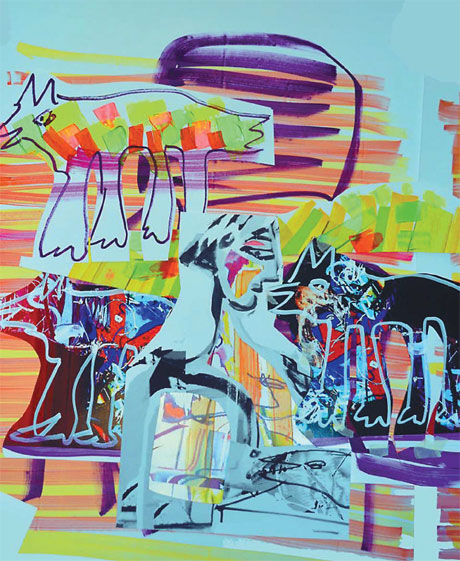For art's sake

Norwegian artist Erik Steffen Alvaer tells how he found a new way of life in China
What to do? What to see? What to buy? Which TV shows or movies to watch? What's the next big thing?
For Erik Steffen Alvaer, the cacophony of life-defining choices in the West have become more than distracting. The intensity of which is overwhelming but ultimately dissatisfying to him.
| Norwegian artist Erik Steffen Alvaer finds artistic inspirations and a surprisingly positive way of life in China. His painting Fabel 2 (above) was part of his recent Beijing exhibition. Photos provided to China Daily |
A decade ago, the Norwegian artist found himself weary of Western values and searching for something more.
"I was, in fact, feeling a depression," he muses while sitting at a quiet coffee shop in Beijing's 798 Art Zone. Looking back on those days, he says, his decision to come to China in 2005 was pretty much random.
"I was looking at the Internet, with the thought of taking a long journey," Alvaer, 60, says.
Then Google pointed him to Nanning, capital city of the Guangxi Zhuang autonomous region, where he found a surprisingly positive way of life and, soon after, a Chinese wife.
"The people were very poor - they didn't have so much," he says. "But they had a real joy of life, singing and dancing in the park. It was quite wonderful."

Now with a Chinese wife and her two grown children, Alvaer travels frequently between his home in Bergen, Norway, and China. Last month, the mixed media artist put up his third exhibition in this country, The Phoenix, after holding two shows in the recent years in Guangzhou and Shanghai.
His first solo exhibition in Guangzhou's Redtory Art District last year was an adventure.
Alvaer is described as an expressionistic painter by his fans, and his brightly colored collage-like works often mix established elements from Western art history with Chinese ornaments and popular culture. After presenting the collection of works he wanted to show, he was told that his paintings were "not appreciated" by provincial authorities.
"It seemed like they could find anything to interpret as a political statement," he says, shrugging. "I had no idea what they meant."
Alaever says he "put on my political glasses to see if there were titles that could be misinterpreted". He saw what might have been an issue in his work, Women Leaving Chinese Room, in which he says the use of the color red may have suggested some unintended symbolism.
"I replaced some pictures, paid careful attention to them, added some recent works," he says. "Then everything was OK. And we got good press coverage and TV."
Even better, he says, was the crowd of young Chinese art students who came to the show. The artist struggled a bit to answer their questions, however, especially the recurring and literal "What does it mean?"
On his website, noting that few Western artists had been shown at the gallery - though among them was Picasso, he writes that his images "were greeted by virgin glances".
"There was a lack of fantasy in the way they looked at things, at art, that surprised me," he says, adding that he thinks that is changing as their exposure to outside art expands. On the other hand, he says, having come to China for inspiration, he found himself surprised by the artistic freedom that he experienced as soon as he arrived.
"I am not a communist," says the artist, who studied psychology, art history and media science in college. "But I find it very interesting, especially today. In Norway, we are more socialist than the Chinese. Here, everybody wants to get rich."
He is impressed, however, by the sense of calm in people that he found when he first came to China.
"People are in control of themselves," he says.
"In part it is their upbringing but also their experience in life. They have not had so many choices, at least until now, and they are more stable."
His current show includes his just-painted Fabel 2, in which peace has been reached between the lion and the lamb, who now eat together. The phoenix stands watch as a spectator, he adds.
"In this image I have made some technical achievements that I have been striving for, a glow in the colors and a 'movement' in the image, as if it's alive," he says.
Among the painter's admirers is Mayra Henriquez, an art historian and a member of The Norwegian Cultural Council.
"Alvaer has been characterized as an expressionistic painter who manages to express thoughts, meanings and subjectivity at the same time as he paradoxically manages to capture the reality manifested around him," she says.
It would be easy to see the phoenix, which otherwise is a mythical bird capable of regeneration, as a reflection of his own life, especially its transformation in the past decade, but the artist suggests we shouldn't try so hard to find meaning there.
"Sometimes, for me," Alvaer says with a sudden smile, "it's art for art's sake."
michaelpeters@chinadaily.com.cn
(China Daily European Weekly 12/12/2014 page29)
Today's Top News
- Japan tempting fate if it interferes in the situation of Taiwan Strait
- Stable trade ties benefit China, US
- Experts advocate increasing scope of BRI to include soft power sectors
- New engine powers cargo drone expansion
- China to boost green industry cooperation
- Manufacturing PMI rises in November































